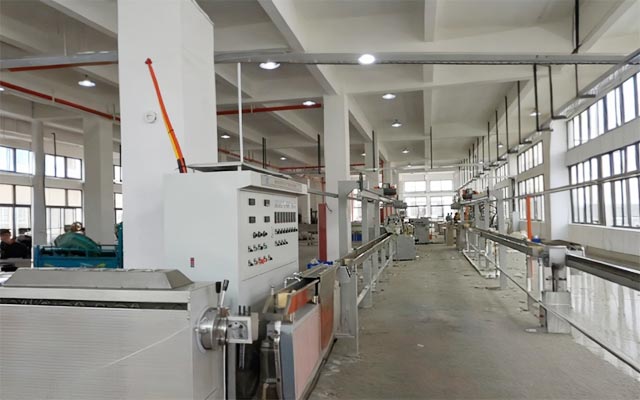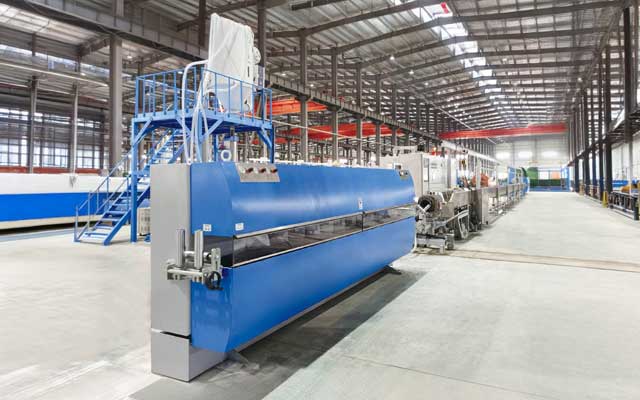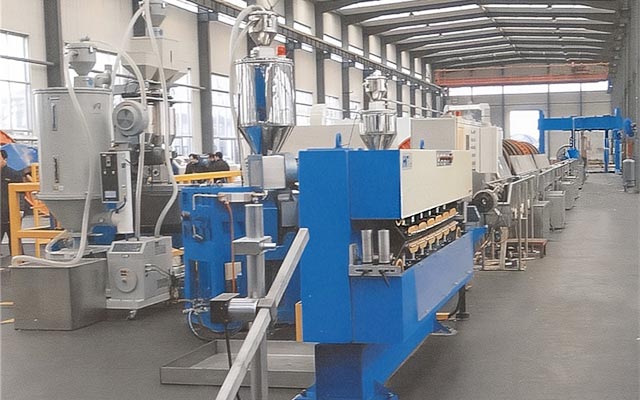Model 50-150Screw Diameter φ50-150L/D Ratio 26:1/25:1Extrusion Output 70-650 kg/hMain Motor 25-220 KWOutlet Diameter 0.8-120 mmSpeed 10-300Application Low-voltage power cable
Low-voltage Power Cable Extrusion Line
The low-voltage power cable extrusion production line is a complete set of equipment specifically designed for manufacturing insulated cores and protective sheaths of power cables rated at 0.6/1 kV and below. Its core process involves melting solid plastics (such as PVC or XLPE) through heating and pressurization, then continuously and uniformly coating conductors (copper/aluminum wires) or assembled cable cores. After cooling and solidification, a smooth, dense, and uniformly thick insulating layer or protective sheath is formed.
Common Types of Low-Voltage Power Cables
| GB Standard |
IEC Standard |
UL/ANSI Standard |
| VV |
NA2XY |
THHN |
| YJV |
NA2XSY |
XHHW-2 |
| YJLV |
H07Z-U |
USE-2 |
| VV22 |
NAYY |
MTW |
| YJV22 |
NA2XY-J |
RHW-2 |
| WDZA-YJY |
/ |
/ |
| NH-YJV |
/ |
/ |
Low-voltage Power Cable Extrusion Line


Core Components
A power cable extrusion production line is a highly coordinated automated system, primarily consisting of the following major components:
Pay-off Unit:Supports and releases the conductor or cable core, providing stable and controllable tension to prevent thinning or twisting of the conductor.
Preheater:Heats the conductor before it enters the die head to remove moisture, reduce internal stress, and improve adhesion between the plastic and the conductor.
Extruder:Screw: Conveys, compacts, melts, and homogenizes the plastic.
Barrel: Heats and cools the plastic.
Drive Motor: Provides power to the screw.
Die Head: Connects the extruder to the die.
Die (Tip and Die): Determines the thickness, concentricity, and shape of the extruded layer.
Cooling Trough:Rapidly cools and solidifies the high-temperature cable. Typically features segmented temperature control to ensure material stability and avoid internal stress.
Haul-off Unit:Provides the driving force for the production line. Its speed must be extremely stable, as it is critical for ensuring uniform extrusion thickness.
Spark Tester:An online quality inspection device that applies high voltage to the insulating layer to detect defects such as pinholes or impurities, triggering alarms and marking the locations.
Take-up Unit:Winds the finished cable neatly onto a reel, maintaining constant tension and synchronizing with the haul-off speed.
Control System:Uses a PLC / industrial computer to centrally control all parameters (temperature, speed, tension, etc.), ensuring stable and reproducible production.
Low-voltage Power Cable Extrusion Line Datasheet
| Model |
50 |
70 |
80 |
90 |
100 |
120 |
150 |
| Screw Diameter (mm) |
φ50 |
φ70 |
φ80 |
φ90 |
φ100 |
φ120 |
φ150 |
| Screw L/D Ratio |
26:1 |
26:1 |
26:1 |
26:1 |
25:1 |
25:1 |
25:1 |
| Extrusion Amount (kg/hr) |
70 |
140 |
200 |
250 |
320 |
450 |
650 |
| Outlet Wire (mm) |
0.8-5 |
2-15 |
3-25 |
5-35 |
8-60 |
10-80 |
15-120 |
| Total Power (KW) |
25 |
40 |
55 |
63 |
120 |
165 |
220 |
| Production Speed(Max., m/min) |
300 |
300 |
200 |
200 |
100 |
80 |
60 |
| Take-up Spool |
400/630 |
500/800 |
800/1250 |
800/1600 |
1000/2000 |
2000/2500 |
2500/3150 |
| Storage Length |
240 m |
240 m |
200 m |
180 m |
0 |
0 |
0 |
Low-voltage Power Cable Extrusion Line Application
The low-voltage power cable extrusion production line is a complete set of equipment specifically designed for producing insulation cores and sheaths of power cables with rated voltage of 0.6/1kV and below. The details are as follows:
Conductor Insulation
Function: Extrudes insulating material onto copper or aluminum conductors to form the primary insulation layer.
Common Materials: Cross-linked polyethylene (XLPE), polyethylene (PE), polyvinyl chloride (PVC), etc.
Requirements: Uniform thickness, high concentricity, absence of impurities, and no microvoids. The insulation extrusion process for high-voltage cables demands the highest technical precision.
Sheathing Extrusion
Function: Extrudes a protective sheath over the assembled cable core.
Purpose: Provides mechanical protection, corrosion resistance, moisture resistance, UV resistance, flame retardancy, etc.
Common Materials: Polyvinyl chloride (PVC), polyethylene (PE), polyolefins, etc.




